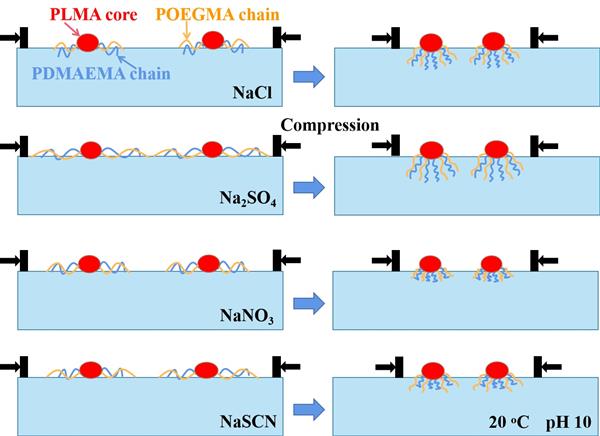30.【Colloids Surf. A】Effects of ionic strength and ion-specificity on the interface behavior of PDMAEMA-b-PLMA-b-POEGMA triblock terpolymer.
writer:Guanying He, Gangyao Wen,* Athanasios Skandalis,Stergios Pispas, Dongxue Liu
keywords:LB film; Block copolymer; Triblock terpolymer; Hofmeister series; Langmuir monolayer
source:期刊
specific source:Colloids and Surfaces A: Physicochemical and Engineering Aspects 2023, 658C, 130659.
Issue time:2022年
Ion-specificity on the stretching degree of diblock copolymers containing poly[2-(dimethylamino)ethyl methacrylate] (PDMAEMA) at the air/water interface has previously been proved to be inconsistent with the Hofmeister series. In this work, the aggregation behavior of an amphiphilic linear triblock terpolymer poly[2-(dimethylamino)ethyl methacrylate]-block-poly(lauryl methacrylate)-block-poly[oligo(ethylene glycol) methacrylate] (PDMAEMA-b-PLMA-b-POEGMA) on the aqueous subphase with different ionic strengths and ion species (salts) was studied, and the morphologies of its Langmuir-Blodgett (LB) films were explored. At the air/water interface, the terpolymer tends to form surface micelles composed of hydrophobic PLMA cores and mixed hydrophilic coronas of PDMAEMA and POEGMA. Under acidic conditions with low ionic strength, the hydrophilic PDMAEMA blocks of the terpolymer are almost completely electrostatic screened. With the increase of subphase ionic strength, the surface pressure?molecular area isotherms of the terpolymer monolayers at the air/water interface gradually move to large areas due to the increased interfacial stretching degree of POEGMA blocks resulting from the increased salting-out effect and interfacial steric hindrance of PDMAEMA blocks. The hysteresis degrees of the terpolymer monolayers in the presence of salts in the subphase are larger than that in the absence of salt. Under alkaline conditions, the isotherms of the terpolymer monolayers move to large areas with the increase of salt concentration because the introduction of salt makes the hydrophilic blocks more stretched. The experimental results show that the relationship between their interfacial stretching degrees of two kinds of hydrophilic blocks and the types of salt in solution is inconsistent with the Hofmeister series. This may be due to tethering of the corona chains on the hydrophobic core and the configurational constrains (crowding phenomena) induced within the mixed micelle corona. Under different subphase conditions, the LB films of the terpolymer show isolated circular micelles due to the mutual repulsions of the long hydrophilic PDMAEMA and POEGMA blocks.

Article address: https://doi.org/10.1016/j.colsurfa.2022.130659